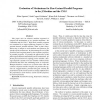Free Online Productivity Tools
i2Speak
i2Symbol
i2OCR
iTex2Img
iWeb2Print
iWeb2Shot
i2Type
iPdf2Split
iPdf2Merge
i2Bopomofo
i2Arabic
i2Style
i2Image
i2PDF
iLatex2Rtf
Sci2ools
ISCA
1993
IEEE
1993
IEEE
Evaluation of Mechanisms for Fine-Grained Parallel Programs in the J-Machine and the CM-5
er uses an abstract machine approach to compare the mechanisms of two parallel machines: the J-Machine and the CM-5. High-level parallel programs are translated by a single optimizing compiler to a finegrained abstract parallel machine, TAM. A final compilation step is unique to each machine and optimizes for specifics of the architecture. By determining the cost of the primitives and weighting them by their dynamic frequency in parallel programs, we quantify the effectiveness of the followingmechanisms individuallyandin combination. Efficient processor/network coupling proves valuable. Message dispatch is found to be less valuable without atomic operations that allow the scheduling levels to cooperate. Multiple hardware contexts are of small value when the contexts cooperate and the compiler can partition the register set. Tagged memory provides little gain. Finally, the performance of the overall system is strongly influenced by the performance of the memory system and the freq...
| Added | 08 Aug 2010 |
| Updated | 08 Aug 2010 |
| Type | Conference |
| Year | 1993 |
| Where | ISCA |
| Authors | Ellen Spertus, Seth Copen Goldstein, Klaus E. Schauser, Thorsten von Eicken, David E. Culler, William J. Dally |
Comments (0)

